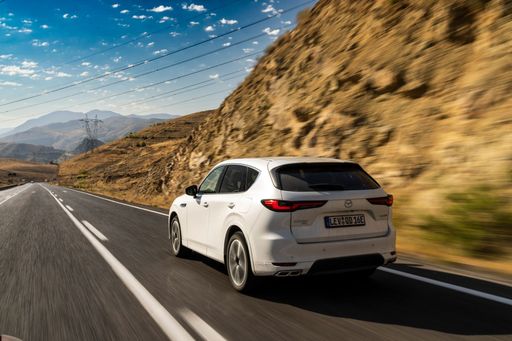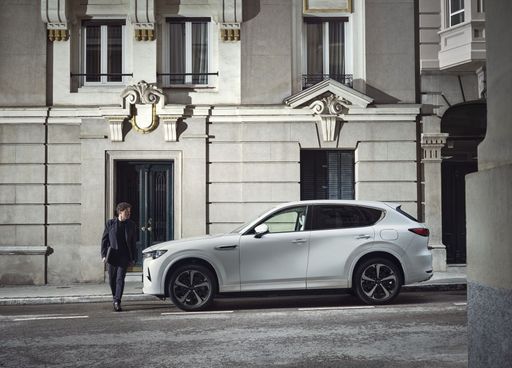Mazda CX-60 vs Hyundai IONIQ 9 – Differences & prices compared
Compare performance, boot space, consumption and price in one view.
Find out now: which car is the better choice for you – Mazda CX-60 or Hyundai IONIQ 9?
The Mazda CX-60 (SUV) comes with a Plugin Hybrid or Diesel MHEV engine and Automatic transmission. In comparison, the Hyundai IONIQ 9 (SUV) features a Electric engine with Automatic transmission.
When it comes to boot capacity, the Mazda CX-60 offers 570 L, while the Hyundai IONIQ 9 provides 338 L – depending on how much space you need. If you’re looking for more power, decide whether the 327 HP of the Mazda CX-60 or the 428 HP of the Hyundai IONIQ 9 suits your needs better.
In terms of consumption, the values are 1.40 L per 100 km for the Mazda CX-60, and 19.90 kWh for the Hyundai IONIQ 9.
Price-wise, the Mazda CX-60 starts at 41900 £, while the Hyundai IONIQ 9 is available from 58700 £. Compare all the details and find out which model fits your lifestyle best!
Mazda CX-60
The Mazda CX-60 exudes a sense of elegance and sophistication with its sleek design and refined styling. Inside, the cabin offers a harmonious blend of comfort and advanced technology, ensuring an enjoyable driving experience. On the road, the CX-60 delivers impressive performance and handling, making it a standout choice for those who appreciate driving dynamics.
details @ de.mazda-press.com
@ de.mazda-press.com
 @ de.mazda-press.com
@ de.mazda-press.com
 @ de.mazda-press.com
@ de.mazda-press.com
 @ de.mazda-press.com
@ de.mazda-press.com
Hyundai IONIQ 9
The Hyundai IONIQ 9 is a bold step forward in the automotive world, combining cutting-edge electric technology with a sleek and modern design. This model stands out with its spacious interior and advanced features, ensuring both comfort and convenience for drivers and passengers alike. As Hyundai pushes the envelope in eco-friendly innovation, the IONIQ 9 represents the future of sustainable driving with its impressive range and performance capabilities.
details

|
|
|
|
|
Costs and Consumption |
|
|---|---|
|
Price
41900 - 56800 £
|
Price
58700 - 74400 £
|
|
Consumption L/100km
1.4 - 5.4 L
|
Consumption L/100km
-
|
|
Consumption kWh/100km
-
|
Consumption kWh/100km
19.9 - 20.6 kWh
|
|
Electric Range
64 km
|
Electric Range
600 - 620 km
|
|
Battery Capacity
-
|
Battery Capacity
110 kWh
|
|
co2
31 - 139 g/km
|
co2
0 g/km
|
|
Fuel tank capacity
50 - 58 L
|
Fuel tank capacity
-
|
Dimensions and Body |
|
|---|---|
|
Body Type
SUV
|
Body Type
SUV
|
|
Seats
5
|
Seats
7
|
|
Doors
5
|
Doors
5
|
|
Curb weight
1890 - 2055 kg
|
Curb weight
2594 - 2689 kg
|
|
Trunk capacity
570 L
|
Trunk capacity
338 L
|
|
Length
4745 mm
|
Length
5060 mm
|
|
Width
1890 mm
|
Width
1980 mm
|
|
Height
1680 - 1688 mm
|
Height
1790 mm
|
|
Payload
581 - 612 kg
|
Payload
586 - 643 kg
|
Engine and Performance |
|
|---|---|
|
Engine Type
Plugin Hybrid, Diesel MHEV
|
Engine Type
Electric
|
|
Transmission
Automatic
|
Transmission
Automatic
|
|
Transmission Detail
Automatic Gearbox
|
Transmission Detail
Reduction Gearbox
|
|
Drive Type
All-Wheel Drive, Rear-Wheel Drive
|
Drive Type
Rear-Wheel Drive, All-Wheel Drive
|
|
Power HP
200 - 327 HP
|
Power HP
218 - 428 HP
|
|
Acceleration 0-100km/h
5.8 - 8.4 s
|
Acceleration 0-100km/h
5.2 - 9.4 s
|
|
Max Speed
200 - 219 km/h
|
Max Speed
190 - 200 km/h
|
|
Torque
450 - 550 Nm
|
Torque
350 - 700 Nm
|
|
Number of Cylinders
4 - 6
|
Number of Cylinders
-
|
|
Power kW
147 - 241 kW
|
Power kW
160 - 315 kW
|
|
Engine capacity
2488 - 3283 cm3
|
Engine capacity
-
|
General |
|
|---|---|
|
Model Year
2024
|
Model Year
2025
|
|
CO2 Efficiency Class
B, D, E
|
CO2 Efficiency Class
A
|
|
Brand
Mazda
|
Brand
Hyundai
|
Mazda CX-60
The Allure of the Mazda CX-60
Exploring the burgeoning SUV market, the Mazda CX-60 presents itself as a unique contender by combining sophisticated design, powerful performance, and pioneering technology. This British article delves into the detailed intricacies of the CX-60, providing an all-encompassing view of what makes this model stand out.
Engines That Lead the Class
The Mazda CX-60 comes equipped with a choice of pioneering engines including the Plug-in Hybrid and Diesel Mild-Hybrid. Whether you prefer the dynamic 327 PS earmarked with the Plug-in Hybrid or the reliable Diesel option delivering up to 254 PS, the range satisfies a diverse array of performance needs. These engines marry power with efficiency as evidenced by fuel consumptions ranging from as low as 1.4 L/100km to 5.4 L/100km—a remarkable feat in the SUV category.
Plug-In Hybrid: A Modern Marvel
The Plug-in Hybrid engine grabs attention with its e-Skyactiv technology, allowing for an electric range of 64 km, making short urban journeys effortlessly emission-free. Paired with an automatic all-wheel drive system, it provides swift acceleration from 0-100 km/h in just 5.8 seconds, while boasting a fuel efficiency that sets a new standard in hybrid innovation.
Diesel Option for the Road Warriors
For enthusiasts who crave longer journeys, the Diesel Mild-Hybrid variant stands steady. Available in both rear-wheel and all-wheel drive configurations, this engine combines an optimal balance of performance and economy. The most robust option, powered by a 3.3-litre six-cylinder formation, is engineered to deliver a smooth ride with a refined power output.
Interiors Crafted for Comfort
The Mazda CX-60 reveals an interior that speaks of luxury and meticulous craftsmanship. With seating for five, the cabin area is accentuated by options including the Takumi line, which couples elegant design with modern technology. Emphasising driver and passenger comfort, the seating materials and arrangement reflect Mazda's dedication to excellence and ergonomics.
Technological Triumphs
At the heart of Mazda's innovation, the CX-60 incorporates a series of technology enhancements aimed at elevating the driving experience. The inclusion of advanced safety features provides reassurance while cutting-edge infotainment systems ensure connectivity without compromising on design.
The Bottom Line
The Mazda CX-60, with a price range of €47,390 to €61,550, offers tremendous value for an SUV of its class. With a clever mix of technology, style, and performance, it becomes clear why this model is leading its segment. Its blend of dynamic powertrains, premium features, and innovative technology make it an enticing option for those in pursuit of a modern SUV.
Final Thoughts
With its captivating design and exemplary features, the Mazda CX-60 not only meets but exceeds the expectations of contemporary SUV enthusiasts. As Mazda continues to refine its vehicle lineup, the CX-60 stands as a testament to their commitment to creating vehicles that deliver both satisfaction and sustainability.
Hyundai IONIQ 9
The All-New Hyundai IONIQ 9: Redefining Electric Mobility
As the automotive world advances towards a sustainable future, the 2025 Hyundai IONIQ 9 emerges as a powerful testament to the fusion of luxury, innovation, and eco-conscious engineering. Designed as a premium electric SUV, the IONIQ 9 offers a blend of advanced electric performance and cutting-edge technology.
Unmatched Performance and Efficiency
The Hyundai IONIQ 9 arrives in multiple variants, catering to diverse driving preferences with its array of power outputs and configurations. At the core, you'll find either a rear-wheel-drive model or an all-wheel-drive setup. The power output ranges from a robust 218 HP for daily efficiency to an exhilarating 428 HP in the high-performance version.
The efficiency of the IONIQ 9 is equally remarkable, boasting an electric consumption between 19.9 and 20.6 kWh per 100 km. This ensures a substantial range of 600 to 620 km on a single charge, powered by a 110 kWh battery capacity. With a top speed ranging between 190 and 200 km/h and a dynamic acceleration capability that propels the SUV from 0-100 km/h in just 5.2 to 9.4 seconds, the IONIQ 9 is engineered for thrill and precision.
Innovative Technological Features
The Hyundai IONIQ 9 is not just about remarkable performance; it is a technological marvel designed for a sophisticated driving experience. Equipped with an automatic transmission system and a reduction gearbox, the IONIQ 9 enhances driver engagement while maintaining seamless power delivery. The zero-emission SUV carries a CO2 efficiency class of A, symbolizing its commitment to eco-friendly transportation.
Advanced safety and infotainment systems underscore the IONIQ 9’s tech-forward nature. Whether navigating busy city streets or exploring open highways, Hyundai's cutting-edge driver-assistance technologies are ever-present, making each journey secure and enjoyable.
Luxurious Design and Comfort
With dimensions measuring 5060 mm in length, 1980 mm in width, and 1790 mm in height, the IONIQ 9's substantial presence on the road is undeniable. Its 7-seater arrangement accommodates families and group travelers with ease, supported by intelligently designed interiors that prioritize comfort and functionality.
The trunk capacity of 338 liters ensures ample space for luggage, making the IONIQ 9 an ideal companion for those long family trips. Coupled with a payload capacity of up to 643 kg, versatility is at the heart of its design ethos.
A Commitment to Sustainability
The Hyundai IONIQ 9 exemplifies Hyundai's steadfast dedication to a sustainable future. With a curb weight ranging from 2594 to 2689 kg, it is engineered to optimize energy usage while delivering dynamic performance. The zero grams CO2 emission underlines its role as an eco-friendly powerhouse in the electric SUV segment.
As Hyundai continues to innovate and push boundaries, the IONIQ 9 sets a new standard for electric luxury vehicles, offering environmentally conscious drivers a chance to lead the charge in sustainable mobility without compromising on style, comfort, or performance.
Conclusion
The Hyundai IONIQ 9 stands as a beacon of the next generation of electric vehicles. Luxury meets responsibility in this masterfully engineered SUV. With its assortment of technical advancements and a firm commitment to reducing the carbon footprint, the IONIQ 9 not only paves the way for future cars but also transforms how we perceive environmentally responsible driving. As we stride into an era of greener motoring, the IONIQ 9 leads with elegance and purpose, truly a testament to Hyundai's innovation legacy.
Which drive types are available for the Mazda CX-60?
Available as All-Wheel Drive or Rear-Wheel Drive.
The prices and data displayed are estimates based on German list prices and may vary by country. This information is not legally binding.
